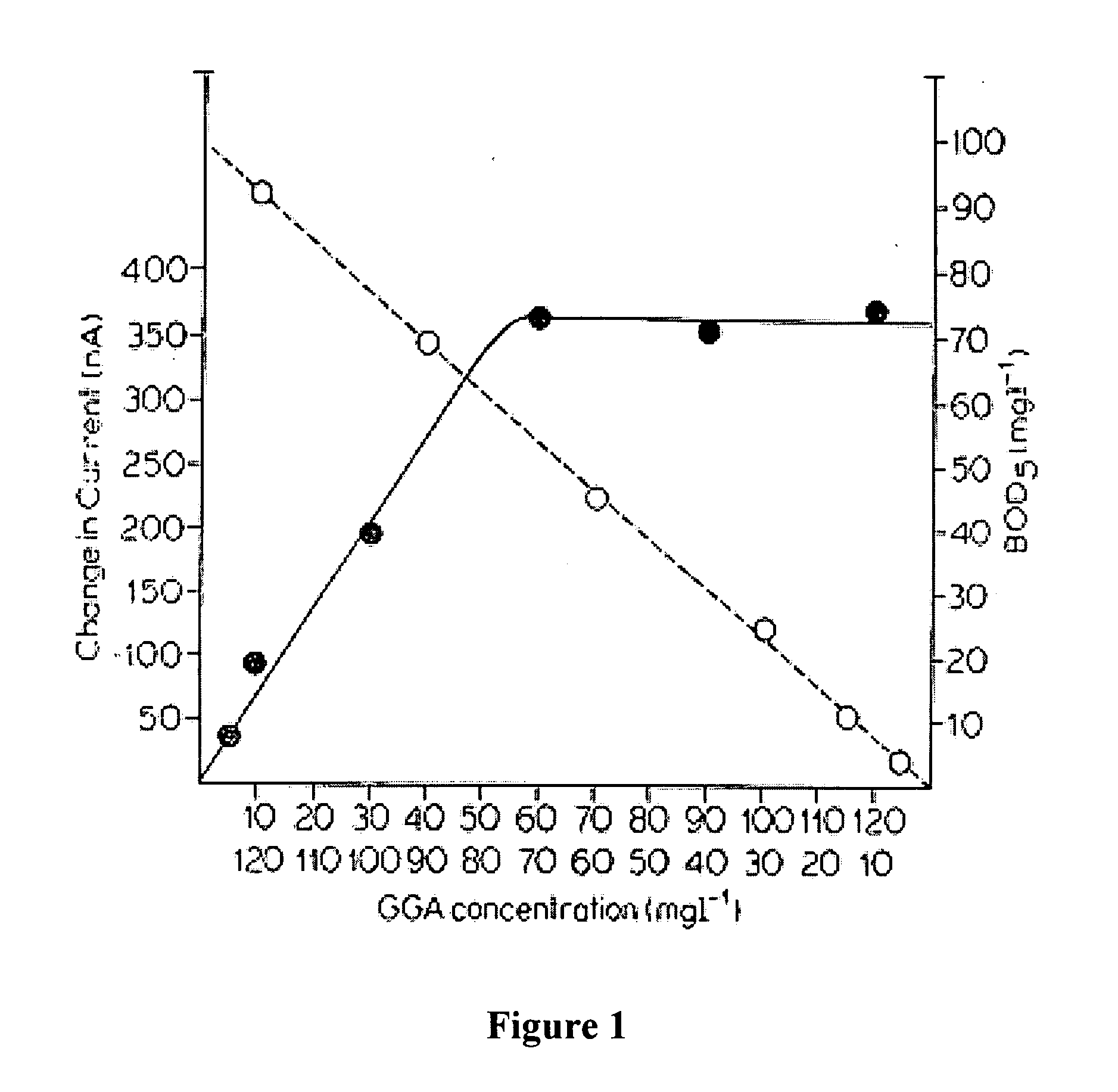Bacterium consortium, bio-electrochemical device and a process for quick and rapid estimation of biological oxygen demand
a bioelectrochemical and biological oxygen technology, applied in the direction of diaphragms, cells, immobilised enzymes, etc., can solve the problems of inability to real-time evaluate the efficiency of waste water treatment or operational control of treatment processes, inability to monitor on-line process monitoring, and inability to meet the requirements of biological oxygen demand. , to achieve the effect of quick estimation of biological oxygen demand
- Summary
- Abstract
- Description
- Claims
- Application Information
AI Technical Summary
Benefits of technology
Problems solved by technology
Method used
Image
Examples
example 1
[0065] Preparation of Immobilized Microbial Membrane
[0066] The immobilization technique of formulated microbial consortium of the present invention is carried out by inoculating the individual strains of the above mentioned bacteria separately in nutrient broth containing (per litre), 5.0 g peptic digest of animal tissue, 5.0 g of sodium chloride, 1.5 g of beef extract, 1.5 g yeast extract and 0.2 ml tween-80. All the cultures are incubated preferably at 37.degree. C. for approximately 16-24 hours in an incubator shaker. For gentle shaking, the incubator shaker is maintained at an appropriate rpm, preferably at 75 rpm. After sufficient growth is obtained, the bacterial cells from these individual cultures are taken in equal proportions based on optical density and then mixed for formulating microbial consortium. The resultant bacterial suspension is centrifuged at an appropriate rpm, preferably at 10,000 rpm for a period of 20 minutes. The resultant pellet is washed by dissolving i...
example 2
[0069] Preparation of a Calibration Curve for Immobilized Microbial Membrane
[0070] GGA was used as a reference standard for all BOD measurements and for the calibration of the beverage sensor as well. Stock solution of GGA having a concentration of 12,000 mg / l was prepared. Different aliquots from the stock solution of GGA were added in the measuring cell of the BOD sensor system, to achieve desired GGA concentrations of 15-300 mg / l (having a BOD of 11-220 mg / l). The response of the sensor with different GGA concentrations was observed and recorded. The readings were plotted and on the same graph, a second mantissa was drawn showing the conventional BOD (BOD5) values against the same GGA concentrations as used with the developed BOD sensor. The linearity of GGA was observed to be between 15 mg / l to 60 mg / l as determined with bioelectrochemical device, as shown in FIG. 1.
example 3
[0071] Selection of Dilution of Beverage Waste Water in Order to Estimate the BOD of Waste Water Using Developed Device.
[0072] The linear range of the developed bio-electrochemical device was up to a GGA concentration of 60 mg / l. The industrial wastewater samples having a high BOD load as calculated from BOD5 analysis do not fall in the linear range of the calibration curve. Therefore, the industrial effluents need to be diluted before their BOD estimation using the developed BOD sensor. For the above said purpose, the percentage of each industrial wastewater sample had to be calculated according to the following devised formula: % of industrial wastewater=Linear range of the sensor ×vol. of buffer in the measuring cellBOD5 value of the industrial wastewater
[0073] Finally, a range of concentrations for each of the wastewater sample above and below the calculated percentage were checked for their BOD load with the help of the developed bio-el...
PUM
| Property | Measurement | Unit |
|---|---|---|
| external polarization voltage | aaaaa | aaaaa |
| external polarization voltage | aaaaa | aaaaa |
| pH | aaaaa | aaaaa |
Abstract
Description
Claims
Application Information
 Login to View More
Login to View More - R&D
- Intellectual Property
- Life Sciences
- Materials
- Tech Scout
- Unparalleled Data Quality
- Higher Quality Content
- 60% Fewer Hallucinations
Browse by: Latest US Patents, China's latest patents, Technical Efficacy Thesaurus, Application Domain, Technology Topic, Popular Technical Reports.
© 2025 PatSnap. All rights reserved.Legal|Privacy policy|Modern Slavery Act Transparency Statement|Sitemap|About US| Contact US: help@patsnap.com


